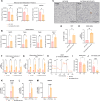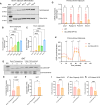Abnormal mitochondrial structure and function in brown adipose tissue of SLC35A4-MP knockout mice
- PMID: 40880489
- PMCID: PMC12396333
- DOI: 10.1126/sciadv.ads7381
Abnormal mitochondrial structure and function in brown adipose tissue of SLC35A4-MP knockout mice
Abstract
Uncovering the role of upstream open reading frames (uORFs) challenges conventional views of one protein per messenger RNA and reveals the capacity of some uORFs to encode microproteins that contribute to cellular biology and physiology. This study explores the functional role of a recently identified mitochondrial microprotein, SLC35A4-MP, in the brown adipose tissue of mice. Our findings reveal dynamic regulation of SLC35A4-MP expression during primary brown adipocyte differentiation in vitro and during cold exposure or high-fat diet (HFD)-induced obesity in mice. Using a knockout mouse model, we show that loss of SLC35A4-MP disrupts mitochondrial lipid composition, decreasing cardiolipins and phosphatidylethanolamine in brown adipose tissue from HFD-fed mice. SLC35A4-MP deficiency also impairs mitochondrial activity, alters mitochondrial number and morphology, and promotes inflammation. Knockout mice accumulate acylcarnitines during cold exposure, indicating defective fatty acid oxidation. These findings reveal SLC35A4-MP as a previously unrecognized microprotein in regulating mitochondrial function and tissue lipid metabolism, adding to the growing list of functional endogenous microproteins.
Figures







References
-
- Basrai M. A., Hieter P., Boeke J. D., Small open reading frames: Beautiful needles in the haystack. Genome Res. 7, 768–771 (1997). - PubMed
-
- Lawrence J., When ELFs are ORFs, but don’t act like them. Trends Genet. 19, 131–132 (2003). - PubMed
-
- Dumesic P. A., Egan D. F., Gut P., Tran M. T., Parisi A., Chatterjee N., Jedrychowski M., Paschini M., Kazak L., Wilensky S. E., Dou F., Bogoslavski D., Cartier J. A., Perrimon N., Kajimura S., Parikh S. M., Spiegelman B. M., An evolutionarily conserved uORF regulates PGC1α and oxidative metabolism in mice, flies, and bluefin tuna. Cell Metab. 30, 190–200.e6 (2019). - PMC - PubMed
MeSH terms
Substances
LinkOut - more resources
Full Text Sources

